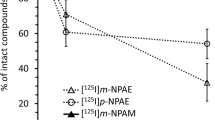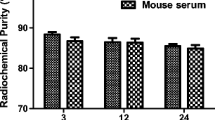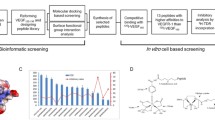Abstract
Purpose
Vascular endothelial growth factor receptors (VEGFRs) are associated with tumor growth and induction of tumor angiogenesis and are known to be overexpressed in various human tumors. In the present study, we prepared and evaluated 68Ga-1,4,7-triazacyclononane-1,4,7-triacetic acid-benzyl (NOTA)-VEGF121 as a positron emission tomography (PET) radioligand for the in vivo imaging of VEGFR expression.
Methods
68Ga-NOTA-VEGF121 was prepared by conjugation of VEGF121 and p-SCN-NOTA, followed by radiolabeling with 68GaCl3 and then purification using a PD-10 column. Human aortic endothelial cell (HAEC) binding of 68Ga-NOTA-VEGF121 was measured as a function of time. MicroPET and biodistribution studies of U87MG tumor xenografted mice were performed at 1, 2, and 4 h after injection of 68Ga-NOTA-VEGF121. The tumor tissues were then sectioned and subjected to immunostaining.
Results
The decay-corrected radiochemical yield of 68Ga-NOTA-VEGF121 was 40 ± 4.5 % and specific activity was 243.1 ± 104.6 GBq/μmol (8.6 ± 3.7 GBq/mg). 68Ga-NOTA-VEGF121 was avidly taken up by HAECs in a time-dependent manner, and the uptake was blocked either by 32 % with VEGF121 or by 49 % with VEGFR2 antibody at 4 h post-incubation. In microPET images of U87MG tumor xenografted mice, radioactivity was accumulated in tumors (2.73±0.32 %ID/g at 2 h), and the uptake was blocked by 40 % in the presence of VEGF121. In biodistribution studies, tumor uptake (1.84±0.14 %ID/g at 2 h) was blocked with VEGF121 at a similar level (52 %) to that of microPET images. Immunostaining analysis of U87MG tumor tissues obtained after the microPET imaging showed high levels of VEGFR2 expression.
Conclusion
These results demonstrate that 68Ga-NOTA-VEGF121 has potential for the in vivo imaging of VEGFR expression. In addition, our results also suggest that the in vivo characteristics of radiolabeled VEGF depend on the properties of the radioisotope and the chelator used.






Similar content being viewed by others
References
Ferrara N, Hillan KJ, Gerber HP, Novotny W. Discovery and development of bevacizumab, an anti-VEGF antibody for treating cancer. Nat Rev Drug Discov 2004;3:391–400.
Underiner TL, Ruggeri B, Gingrich DE. Development of vascular endothelial growth factor receptor (VEGFR) kinase inhibitors as anti-angiogenic agents in cancer therapy. Curr Med Chem 2004;11:731–45.
Roskoski Jr R. Vascular endothelial growth factor (VEGF) signaling in tumor progression. Crit Rev Oncol Hematol 2007;62:179–213.
Takahashi Y, Kitadai Y, Bucana CD, Cleary KR, Ellis LM. Expression of vascular endothelial growth factor and its receptor, KDR, correlates with vascularity, metastasis, and proliferation of human colon cancer. Cancer Res 1995;55:3964–8.
Ferrara N. VEGF and the quest for tumour angiogenesis factors. Nat Rev Cancer 2002;2:795–803.
Roodhart JM, Langenberg MH, Witteveen E, Voest EE. The molecular basis of class side effects due to treatment with inhibitors of the VEGF/VEGFR pathway. Curr Clin Pharmacol 2008;3:132–43.
Sun J, Wang D, Jain RK, Carie A, Paquette S, Ennis E, et al. Inhibiting angiogenesis and tumorigenesis by a synthetic molecule that blocks binding of both VEGF and PDGF to their receptors. Oncogene 2005;24:4701–9.
Ferrara N. Role of vascular endothelial growth factor in physiologic and pathologic angiogenesis: therapeutic implications. Semin Oncol 2002;29(6 Suppl 16):10–4.
Jain RK. Tumor angiogenesis and accessibility: role of vascular endothelial growth factor. Semin Oncol 2002;29(6 Suppl 16):3–9.
Kerbel RS. Tumor angiogenesis: past, present and the near future. Carcinogenesis 2000;21:505–15.
Laird AD, Vajkoczy P, Shawver LK, Thurnher A, Liang C, Mohammadi M, et al. SU6668 is a potent antiangiogenic and antitumor agent that induces regression of established tumors. Cancer Res 2000;60:4152–60.
Miao RQ, Agata J, Chao L, Chao J. Kallistatin is a new inhibitor of angiogenesis and tumor growth. Blood 2002;100:3245–52.
Morin MJ. From oncogene to drug: development of small molecule tyrosine kinase inhibitors as anti-tumor and anti-angiogenic agents. Oncogene 2000;19:6574–83.
Wedge SR, Ogilvie DJ, Dukes M, Kendrew J, Curwen JO, Laurent F, et al. ZD4190: an orally active inhibitor of vascular endothelial growth factor signaling with broad-spectrum antitumor efficacy. Cancer Res 2000;60:970–5.
Backer MV, Levashova Z, Patel V, Jehning BT, Claffey K, Blankenberg FG, et al. Molecular imaging of VEGF receptors in angiogenic vasculature with single-chain VEGF-based probes. Nat Med 2007;13:504–9.
Nagengast WB, Lub-de Hooge MN, Oosting SF, den Dunnen WFA, Warnders FJ, Brouwers AH, et al. VEGF-PET imaging is a noninvasive biomarker showing differential changes in the tumor during sunitinib treatment. Cancer Res 2011;71:143–53.
Ferrara N. Vascular endothelial growth factor: molecular and biological aspects. Curr Top Microbiol Immunol 1999;237:1–30.
Robinson CJ, Stringer SE. The splice variants of vascular endothelial growth factor (VEGF) and their receptors. J Cell Sci 2001;114:853–65.
Keyt BA, Berleau LT, Nguyen HV, Chen H, Heinsohn H, Vandlen R, et al. The carboxyl-terminal domain (111-165) of vascular endothelial growth factor is critical for its mitogenic potency. J Biol Chem 1996;271:7788–95.
Zhang HT, Scott PA, Morbidelli L, Peak S, Moore J, Turley H, et al. The 121 amino acid isoform of vascular endothelial growth factor is more strongly tumorigenic than other splice variants in vivo. Br J Cancer 2000;83:63–8.
Cheng SY, Nagane M, Su Huang HJ, Cavenee WK. Intracerebral tumor-associated hemorrhage caused by overexpression of vascular endothelial growth factor (VEGF) isoforms VEGF121 and VEGF165 but not VEGF189. Proc Natl Acad Sci U S A 1997;94:12081–7.
Ma SH, Le HB, Jia BH, Wang ZX, Xiao ZW, Cheng XL. Peripheral pulmonary nodules: relationship between multi-slice spiral CT perfusion imaging and tumor angiogenesis and VEGF expression. BMC Cancer 2008;8:186.
Yoshimoto M, Kinuya S, Kawashima A, Nishii R, Yokoyama K, Kawai K. Radioiodinated VEGF to image tumor angiogenesis in a LS180 tumor xenograft model. Nucl Med Biol 2006;33:963–9.
Li S, Peck-Radosavljevic M, Kienast O, Preitfellner J, Havlik E, Schima W, et al. Iodine-123-vascular endothelial growth factor-165 (123I-VEGF165). Biodistribution, safety and radiation dosimetry in patients with pancreatic carcinoma. Q J Nucl Med Mol Imaging 2004;48:198–206.
Cornelissen B, Oltenfreiter R, Kersemans V, Staelens L, Frankenne F, Foidart JM, et al. In vitro and in vivo evaluation of [123I]-VEGF165 as a potential tumor marker. Nucl Med Biol 2005;32:431–6.
Cai W, Chen K, Mohamedali KA, Cao Q, Gambhir SS, Rosenblum MG, et al. PET of vascular endothelial growth factor receptor expression. J Nucl Med 2006;47:2048–56.
Willmann JK, Chen K, Wang H, Paulmurugan R, Rollins M, Cai W, et al. Monitoring of the biological response to murine hindlimb ischemia with 64Cu-labeled vascular endothelial growth factor-121 positron emission tomography. Circulation 2008;117:915–22.
Cai W, Guzman R, Hsu AR, Wang H, Chen K, Sun G, et al. Positron emission tomography imaging of poststroke angiogenesis. Stroke 2009;40:270–7.
Rodriguez-Porcel M, Cai W, Gheysens O, Willmann JK, Chen K, Wang H, et al. Imaging of VEGF receptor in a rat myocardial infarction model using PET. J Nucl Med 2008;49:667–73.
Blankenberg FG, Mandl S, Cao YA, O’Connell-Rodwell C, Contag C, Mari C, et al. Tumor imaging using a standardized radiolabeled adapter protein docked to vascular endothelial growth factor. J Nucl Med 2004;45:1373–80.
Eder M, Krivoshein AV, Backer M, Backer JM, Haberkorn U, Eisenhut M. ScVEGF-PEG-HBED-CC and scVEGF-PEG-NOTA conjugates: comparison of easy-to-label recombinant proteins for [68Ga]PET imaging of VEGF receptors in angionic vasculature. Nucl Med Biol 2010;37:405–12.
Clarke ET, Martell AE. Stabilities of trivalent metal ion complexes of tetraacetate derivatives of 12-, 13- and 14-membered tetraazamacrocycles. Inorganica Chim Acta 1991;190:37–46.
Clarke ET, Martell AE. Stabilities of the Fe(III), Ga(III), and In(III) chelates of N,N′,N″-triazacyclononanetriacetic acid. Inorganica Chim Acta 1991;181:273–80.
Studer M, Meares CF. Synthesis of novel 1,4,7-triazacyclononane-N,N′,N″-triacetic acid derivatives suitable for protein labeling. Bioconjug Chem 1992;3:337–41.
McMurry TJ, Brechbiel M, Wu C, Gansow OA. Synthesis of 2-(p-thiocyanatobenzyl)-1,4,7-triazacyclononane-1,4,7-triacetic acid: application of the 4-methoxy-2,3,6-trimethylbenzenesulfonamide protecting group in the synthesis of macrocyclic polyamines. Bioconjug Chem 1993;4:236–45.
Shetty D, Lee YS, Jeong JM. 68Ga-labeled radiopharmaceuticals for positron emission tomography. Nucl Med Mol Imaging 2010;44:233–40.
Jeong JM, Hong MK, Chang YS, Lee YS, Kim YJ, Cheon GJ, et al. Preparation of a promising angiogenesis PET imaging agent: 68Ga-labeled c(RGDyK)-isothiocyanatobenzyl-1,4,7-triazacyclononane-1,4,7-triacetic acid and feasibility studies in mice. J Nucl Med 2008;49:830–6.
Xiong Y, Huo Y, Chen C, Zeng H, Lu X, Wei C, et al. Vascular endothelial growth factor (VEGF) receptor-2 tyrosine 1175 signaling controls VEGF-induced von Willebrand factor release from endothelial cells via phospholipase C-gamma 1- and protein kinase A-dependent pathways. J Biol Chem 2009;284:23217–24.
Santos SCR, Miguel C, Domingues I, Calado A, Zhu Z, Wu Y, et al. VEGF and VEGFR-2 (KDR) internalization is required for endothelial recovery during wound healing. Exp Cell Res 2007;313:1561–74.
Mukherjee S, Tessema M, Wandinger-Ness A. Vesicular trafficking of tyrosine kinase receptors and associated proteins in the regulation of signaling and vascular function. Circ Res 2006;98:743–56.
Ferrara N. Vascular endothelial growth factor: basic science and clinical progress. Endocr Rev 2004;25:581–611.
Witmer AN, Dai J, Weich HA, Vrensen GFJM, Schlingemann RO. Expression of vascular endothelial growth factor receptors 1, 2, and 3 in quiescent endothelia. J Histochem Cytochem 2002;50:767–77.
Tammela T, Enholm B, Alitalo K, Paavonen K. The biology of vascular endothelial growth factors. Cardiovasc Res 2005;65:550–63.
Hoigebazar L, Jeong JM, Hong MK, Kim YJ, Lee JY, Shetty D, et al. Synthesis of 68Ga-labeled DOTA-nitroimidazole derivatives and their feasibilities as hypoxia imaging PET tracers. Bioorg Med Chem 2011;19:2176–81.
Hoigebazar L, Jeong JM, Choi SY, Choi JY, Shetty D, Lee YS, et al. Synthesis and characterization of nitroimidazole derivatives for 68Ga-labeling and testing in tumor xenografted mice. J Med Chem 2010;53:6378–85.
Acknowledgements
This work was supported by the National Research Foundation of Korea (NRF) grants funded by the Korean government (MEST) (No. 2011-0027525 and 2011-0030164).
Author information
Authors and Affiliations
Corresponding authors
Rights and permissions
About this article
Cite this article
Kang, C.M., Kim, SM., Koo, HJ. et al. In vivo characterization of 68Ga-NOTA-VEGF121 for the imaging of VEGF receptor expression in U87MG tumor xenograft models. Eur J Nucl Med Mol Imaging 40, 198–206 (2013). https://doi.org/10.1007/s00259-012-2266-x
Received:
Accepted:
Published:
Issue Date:
DOI: https://doi.org/10.1007/s00259-012-2266-x




